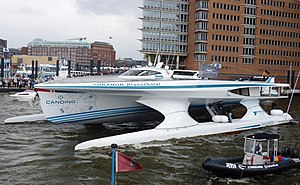Future boat developments
Two aims of future boat development are fuel efficiency through reduction of drag and protection of the environment against pollution through use of 'cleaner' fuel sources.

Professor James J. Corbett of the University of Delaware has suggested that a 20–30% GHG-emissions reduction for shipping is possible and may occasion economical and health benefits.[1]
Drag reduction[edit]
Composition[edit]
Reduction in drag may offer significant fuel efficiency. Advancements in technology such as aluminum alloys or carbon-fiber composites may reduce hull weight (and hence displacement and drag) for a given payload.[citation needed]
Hull shape[edit]
A bulbous bow is a protruding bulb at the bow of a ship. It is positioned just below the waterline to modify the way water flows around the hull. Large ships with bulbous bows have a twelve to fifteen percent better fuel efficiency than similar vessels without them.[2] Drag may be reduced by decreasing the effective wetted area of the hull. In Skjold class patrol boats this is achieved by augmenting the buoyancy by incorporating a fan-blown skirted compartment between the two rigid catamaran-type hulls. This design permits lower displacement and therefore reduced drag at high speeds. A related concept is the air cavity system.[3] Creating an air cavity on the underside of a hull may reduce drag by up to 15%.[4]
Cleaner energy[edit]
Wind power[edit]


Wind power has been used to propel watercraft since prehistoric times. Classic sails are, however, poorly suited for modern economic conditions. This is because their efficiency depends on the weather and because large crews are required to handle them. Some designs try to overcome these issues. One example is the windmill ship which captures wind energy with a rotor that drives a conventional propeller. Another is the SkySails propulsion system. It is a large foil kite with an electronic control system which can be automatically set. The kites, having an area of approximately 320 square meters (3,400 sq ft), can be flown at altitudes of 100–300 meters (330–980 ft). Due to the stronger winds at these heights, they receive a higher thrust per unit area than conventional mast-mounted sails. A ship equipped with the SkySails could attain an increase in fuel efficiency of 10 to 35%.[5] Despite a number of attempts, Flettner ships have not been successful. However, Jacques Cousteau made improvements in his design, the Turbosail. Unlike simple Flettner rotors, Turbosail is able to produce thrust in the direction of travel, regardless of wind direction. The first turbosail-equipped ship, Alcyone, reported a 1/3 fuel saving. The efficiency of the system has not, however, been subjected to adequate comparison. Only two turbosail-equipped vessels have undergone research.[citation needed]
Other energy sources[edit]

Fuel cell powered boats may benefit from the higher thermodynamic efficiency of fuel cells compared to internal combustion engines (40-60% vs 20-25%). However, fuel cells are costly. In 2009, the United States of America's Department of Energy estimated the cost of an 80-kW automotive fuel cell system in volume production (projected to 500,000 units per year) at US$61 per kilowatt.[6] Solar panels have been also suggested for powering primary and secondary ship systems.[7][8] Solar powered boats are usually limited to rivers and canals. In 2007, an experimental 14m catamaran, the 'Sun21' sailed the Atlantic from Seville to Miami, and from there to New York.[9]
See also[edit]
References[edit]
- ↑ "James Corbett claiming 20-30% GHG-emissions reduction for shipping is possible as well as economical and health benefits".
- ↑ Bray, Patrick J. (April 2005). "Bulbous bows".
- ↑ Konstantin Matveev, MSc (PhD candidate California Institute of Technology) (2003). "Air-cavity ships are ready for a wider market". Speed at Sea.
- ↑ DK Group ACS-boat model
- ↑ Steve Rosenberg (23 January 2008). Gone with the wind on 'kite ship'. BBC (retrieved January 4, 2011)
- ↑ "Fuel cell system cost" (PDF).
- ↑ Solar panels for secondary systems power
- ↑ "Solar panel-powered boats".
- ↑ "Solar boat makes Atlantic history". BBC News. 30 March 2007. Retrieved 2010-06-01.
External links[edit]
This article "Future boat developments" is from Wikipedia. The list of its authors can be seen in its historical. Articles copied from Draft Namespace on Wikipedia could be seen on the Draft Namespace of Wikipedia and not main one.
